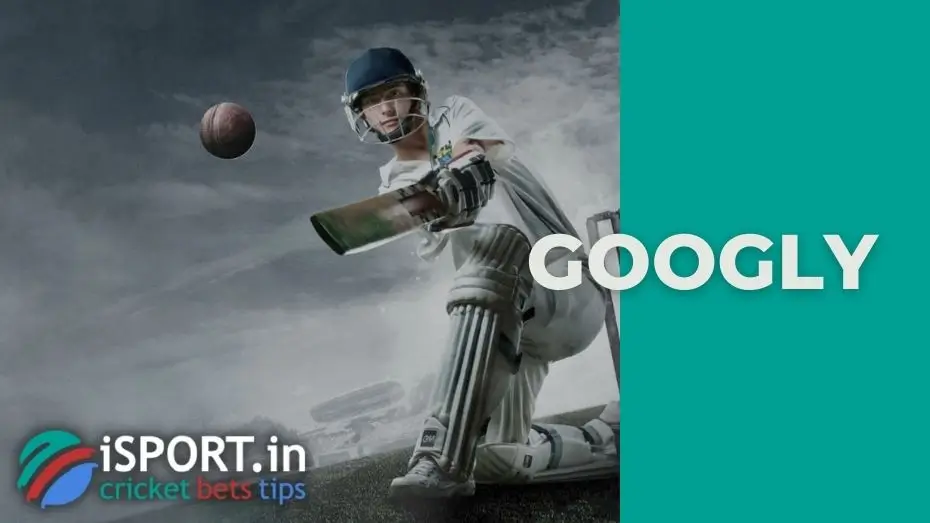Googly

The main pleasure in cricket is watching how a bowler tries to “deceive” a batsman using various techniques when serving. This constant pursuit of beautiful throws of the ball and attempts to outwit the opponent leads to the development of a variety of serving techniques are being developed, one more difficult than the other.
In this article, we will talk about the Googly technique. Experienced bowlers will probably say that it takes a tremendous amount of skill to execute this serve, and they will be right. The beauty of Googly lies in masking the throw when confusion is introduced into the game of an unsuspecting batsman. All the details about this unusual term are in our material.
Googly: what is it
In very simple words, Googly is a type of throw where the ball’s rotation causes it to deviate sharply towards the right-handed batsman’s leg.
While a normal leg break rotates from the leg to the left side (when playing with a right-handed batsman), Googly rotates from the other side, from off to the leg, for a right-handed batsman. The bowler achieves a similar effect by sharply bending the wrist from the normal position when performing a leg break. When the ball is rolled out of the hand (from the side next to the little finger, as in a normal leg break), it comes out with a clockwise rotation (from the bowler’s side).
Experienced batsmen can notice a change in the bowler’s wrist movement, but a well-implemented Googly is successful in most cases. The batsman expects the ball to move as with a normal leg break, and as a result, it bounces in a completely other direction, reaching its goal.

Googly: the history of the origin of the term
The creation of the Googly technique is attributed to the English bowler Bernard Bosanquet. He developed this throw while studying at Oxford University at the end of the XIX century. It is therefore not surprising that among cricketers, a synonym for this serve is often used – “Bosie”.
Bosanquet said he got the idea for the Googly technique while playing a game of Twisti-Twosti, during which players stood at opposite ends of the table and hit the ball on the tabletop, trying to prevent the opponent from catching it. Bernard realized that he could easily outwitte his opponent by throwing two or three balls that flew in one direction and throwing a confusing third or fourth ball in the other direction.
After some time, he transferred his theory to cricket and tested it in action. Bernard Bosanquet came up with a preliminary version of Googly, and it didn’t take long to see its practical application. As planned, the deception left the batsman perplexed, and the ball reached the wicket. Subsequently, the athlete spent years perfecting his new bowling technique. It is not surprising that he became the first athlete in the world to use this throw effectively: with its help, Bosanquet, playing for Middlesex, outwitted Samuel Coe from Leicestershire. This happened in 1900.
According to the Oxford English Dictionary, the origin of the name of the Googly throw is unknown. Moreover, many cricketers continue to use the word “Bosie”. However, Googly is considered an established term in the world practice and is used as an official concept.
Googly: the technique of performance
It takes a lot of practice to perform Googly correctly. It is a very difficult technique that requires certain physical skills. Beginner bowlers find it difficult to implement; for them, the hands and fingers movements when performing Googly seem unnatural. That is why results can only be achieved through long and persistent training.
In a text format, it isn’t easy to make it clear how to do Googly. But we’ll try. In addition, we recommend watching video instructions on YouTube, where this technique is shown in slow motion.
- The ball should be taken in exactly the same way as with a normal leg break, but at the same time, the thumb must be placed under the ball, and the index and middle fingers must be placed at the top.
- When preparing to serve, the back of the hand should be in full view of the batsman to mask the movement of the fingers on the ball. In this case, the palm should be turned up.
- The wrist should be facing the ground at an angle of 180 degrees, and the ball’s seam should be in the direction of the fine leg.
- If the technique is performed correctly, the ball will bounce off the seam, go to the batsman’s direction, and not fly away from him.
Now you know what Googly is. At the same time, the throw is still not fully studied; cricketers continue to argue how to perform this technique perfectly. However, those who get an effective Googly always receive a standing ovation from the audience and the team.
